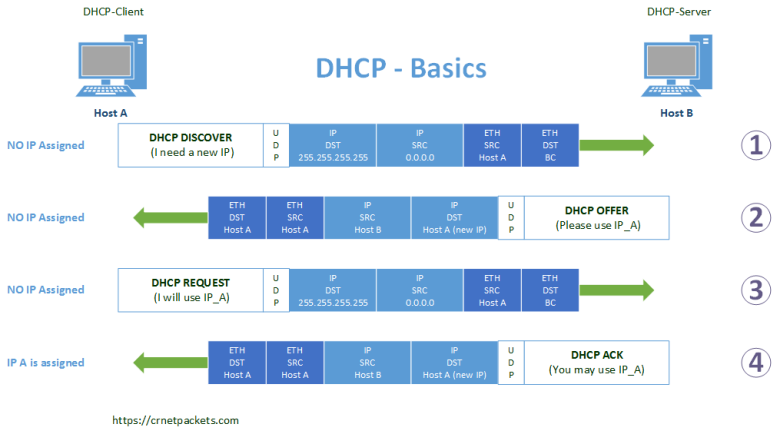IPv4/DHCP/Server
Erscheinungsbild
DHCP (Dynamic Host Configuration Protocol)
Allgemein
- ist Erweiterung des Bootstrap-Protokolls (BOOTP)
- ist ein Hintergrundprozess (Dienst/Daemon)
- definiert in RFC 2131
- Transport durch UDP
- Standard-Ports:
- IPv4: 67 (Server od. Relay-Agent) 68 (Client)
- IPv6: 547 (Server od. Relay-Agent) 546 (Client)
Aufgabe
- angeschlossene Clients ohne manuelle Konfiguration der Schnittstelle in ein bestehendes Netz einbinden,
- das heißt die Konfigurationsparameter...
- IP-Adresse, die Adresse eines Gerätes im Netzwerk,
- Netzmaske, Adressierung des Netz- und Hostteils einer IP-Adresse,
- Gateway, die Brücke von einem ins andere Netz,
- Rechnername,
- Broadcast-Adresse,
- Boot-Image für plattenlose Workstations,
- NetBIOS Nameserver und Name Server (DNS)
- Time- und NTP-Server, die für die Synchronisierung der Uhrzeit zuständig sind,
- ...können automatisch vergeben werden
Betriebsmodi
- manuelle Zuordnung (statisches DHCP):
- IP-Adressen werden bestimmte MAC-Adressen fest zugeordnet; z.B. wichtig bei Port-Weiterleitungen oder wenn DHCP-Client Server-Dienste zur Verfügung stellt
- Nachteil: kein „einfaches“ Einbinden von neuen Clients
- automatische Zuordnung:
- am DHCP-Server wird ein Bereich (range) von IP-Adressen definiert IP-Adressen werden automatisch an die MAC-Adressen von neuen DHCP-Clients zugewiesen und keinem anderen Host mehr zugewiesen
- Zuweisungen sind permanent, werden nicht entfernt und in einer Tabelle eingetragen (/var/lib/dhcpd.leases)
- Nachteil: neue Clients erhalten keine IP-Adresse, wenn der gesamte Adressbereich vergeben ist, auch wenn die bereits vergebenen IP-Adressen nicht aktiv genutzt werden
- dynamische Zuordnung:
- automatische Zuordnung mit Lease-Time
- in Konfigurationdatei (/etc/dhcp/dhcpd.conf) wird festgelegt, wie lange eine IP-Adresse an Client „verliehen“ wird, bevor Client beim Server eine „Verlängerung“ beantragen muss
- Vorteil: bei „Nicht-Verlängerung“ durch Client wird IP-Adresse frei und neu vergeben
Ablauf
- DHCP-DISCOVER: Client sucht per Broadcast nach DHCP-Server
- DHCP-OFFER: DHCP-Server bietet Client per Unicast Konfigurationsparameter der Schnittstelle an
- DHCP-REQUEST: Client fordert angebotene Konfigurationsparameter bei DHCP-Server an (z.B. Mietanfrage)
- DHCP-ACK: DHCP-Server sendet Konfigurationsparameter an Client

Einrichtung unter Linux/Debian am Beispiel "isc-dhcp-server"
Installation
root@pc10:~# apt install isc-dhcp-server
Konfiguration
wichtige Dateien:
- "/etc/default/isc-dhcp-server"
- "/etc/dhcp/dhcpd.conf"
/etc/default/isc-dhcp-server
Hier muss festgelegt werden, an welches Netzwerkgerät der DHCP-Server gebunden werden soll. Hier soll das Netzwerkgerät "enp5s1" an den DHCP-Server gebunden werden.
# On what interfaces should the DHCP server (dhcpd) serve DHCP requests? # Separate multiple interfaces with spaces, e.g. "eth0 eth1". INTERFACESv4="enp5s1" INTERFACESv6=""
/etc/dhcp/dhcpd.conf
Festlegung von ...
- Authoritative-Statement
- Lease-Time
- Subnet-Blöcke
- Range
- Options - z.B. Router, Domain-Name-Server
# dhcpd.conf
#
# Sample configuration file for ISC dhcpd
#
# option definitions common to all supported networks...
option domain-name "example.org";
option domain-name-servers ns1.example.org, ns2.example.org;
default-lease-time 600;
max-lease-time 7200;
# The ddns-updates-style parameter controls whether or not the server will
# attempt to do a DNS update when a lease is confirmed. We default to the
# behavior of the version 2 packages ('none', since DHCP v2 didn't
# have support for DDNS.)
ddns-update-style none;
# If this DHCP server is the official DHCP server for the local
# network, the authoritative directive should be uncommented.
#authoritative;
# Use this to send dhcp log messages to a different log file (you also
# have to hack syslog.conf to complete the redirection).
#log-facility local7;
# No service will be given on this subnet, but declaring it helps the
# DHCP server to understand the network topology.
#subnet 10.152.187.0 netmask 255.255.255.0 {
#}
# This is a very basic subnet declaration.
#subnet 10.254.239.0 netmask 255.255.255.224 {
# range 10.254.239.10 10.254.239.20;
# option routers rtr-239-0-1.example.org, rtr-239-0-2.example.org;
#}
# This declaration allows BOOTP clients to get dynamic addresses,
# which we don't really recommend.
#subnet 10.254.239.32 netmask 255.255.255.224 {
# range dynamic-bootp 10.254.239.40 10.254.239.60;
# option broadcast-address 10.254.239.31;
# option routers rtr-239-32-1.example.org;
#}
# A slightly different configuration for an internal subnet.
#subnet 10.5.5.0 netmask 255.255.255.224 {
# range 10.5.5.26 10.5.5.30;
# option domain-name-servers ns1.internal.example.org;
# option domain-name "internal.example.org";
# option routers 10.5.5.1;
# option broadcast-address 10.5.5.31;
# default-lease-time 600;
# max-lease-time 7200;
#}
# Hosts which require special configuration options can be listed in
# host statements. If no address is specified, the address will be
# allocated dynamically (if possible), but the host-specific information
# will still come from the host declaration.
#host passacaglia {
# hardware ethernet 0:0:c0:5d:bd:95;
# filename "vmunix.passacaglia";
# server-name "toccata.example.com";
#}
# Fixed IP addresses can also be specified for hosts. These addresses
# should not also be listed as being available for dynamic assignment.
# Hosts for which fixed IP addresses have been specified can boot using
# BOOTP or DHCP. Hosts for which no fixed address is specified can only
# be booted with DHCP, unless there is an address range on the subnet
# to which a BOOTP client is connected which has the dynamic-bootp flag
# set.
#host fantasia {
# hardware ethernet 08:00:07:26:c0:a5;
# fixed-address fantasia.example.com;
#}
# You can declare a class of clients and then do address allocation
# based on that. The example below shows a case where all clients
# in a certain class get addresses on the 10.17.224/24 subnet, and all
# other clients get addresses on the 10.0.29/24 subnet.
#class "foo" {
# match if substring (option vendor-class-identifier, 0, 4) = "SUNW";
#}
#shared-network 224-29 {
# subnet 10.17.224.0 netmask 255.255.255.0 {
# option routers rtr-224.example.org;
# }
# subnet 10.0.29.0 netmask 255.255.255.0 {
# option routers rtr-29.example.org;
# }
# pool {
# allow members of "foo";
# range 10.17.224.10 10.17.224.250;
# }
# pool {
# deny members of "foo";
# range 10.0.29.10 10.0.29.230;
# }
#}